December 2025

The global stem cells market size was estimated at US$ 14.92 billion in 2023 and is projected to grow to US$ 49.26 billion by 2034, rising at a compound annual growth rate (CAGR) of 11.47% from 2023 to 2034.
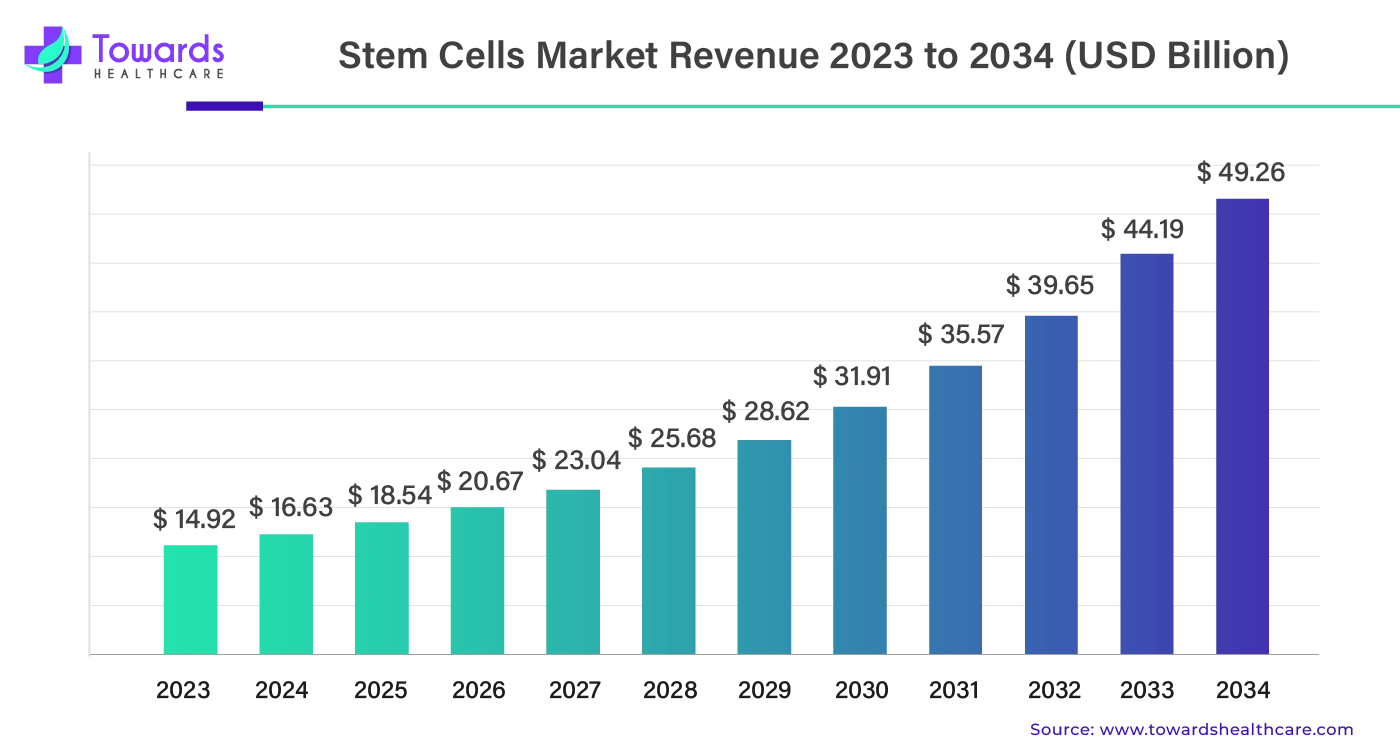
| Metric | Details |
| Market Size in 2024 | USD 16.63 Billion |
| Projected Market Size in 2034 | USD 49.26 Billion |
| CAGR (2025 - 2034) | 11.47% |
| Leading Region | North America |
| Market Segmentation | By Product, By Application, By Technology, By Therapy, By End-use and By Region |
| Top Key Players | STEMCELL Technologies Inc., Mayo Clinic, CellGenix GmbH, Merck KGaA, Takara Bio, PromoCell GmbH, Cellartis AB, AcceGen, ATCC, Lonza, Bio-Techne, Cell Applications, Inc., and Thermo Fisher Scientific, Inc. |
The ability of stem cells to self-renew is amazing. In the early stages of life and growth, they can differentiate into a wide variety of cell types in the body. Researchers have investigated numerous varieties of stem cells. Stem cells can be used by researchers to understand human biology and create new treatments. Improved comprehension of the genetic and molecular cues that control stem cell proliferation, specialization, and differentiation might provide insights into the etiology of disorders and provide novel therapeutic approaches.
The state of regenerative medicine is being advanced by stem cell treatment, but up until now, scientists and medical professionals have had to meticulously assess the quality of each stem cell by closely examining it under a microscope. Using the capabilities of artificial intelligence (AI), Japanese researchers have now discovered a technique to accelerate this procedure. Tokyo Medical and Dental University (TMDU) researchers revealed in a paper published in February in Stem Cells that their artificial intelligence (AI) system, named DeepACT, can detect healthy, productive skin stem cells with the same accuracy as a person.
For instance,
Right now, bone marrow transplantation is the most widely utilized stem cell-based treatment. The first stem cells to be identified and employed in a clinical setting were blood-forming stem cells found in the bone marrow. Thousands of patients worldwide who have been afflicted with blood malignancies, including leukemia, have benefited from this life-saving procedure. Research indicates that bone marrow transplants may be helpful in treating autoimmune illnesses and improving organ tolerance, in addition to their present usage in cancer therapies.
For instance,
Additionally, there are strong ethical and political debates around human stem cell (hSC) research. The donation of a frozen embryo raises a number of ethical issues, such as the donor's informed permission, the consent of the gamete donors who assisted in the production of the embryo, and the privacy of donor data.
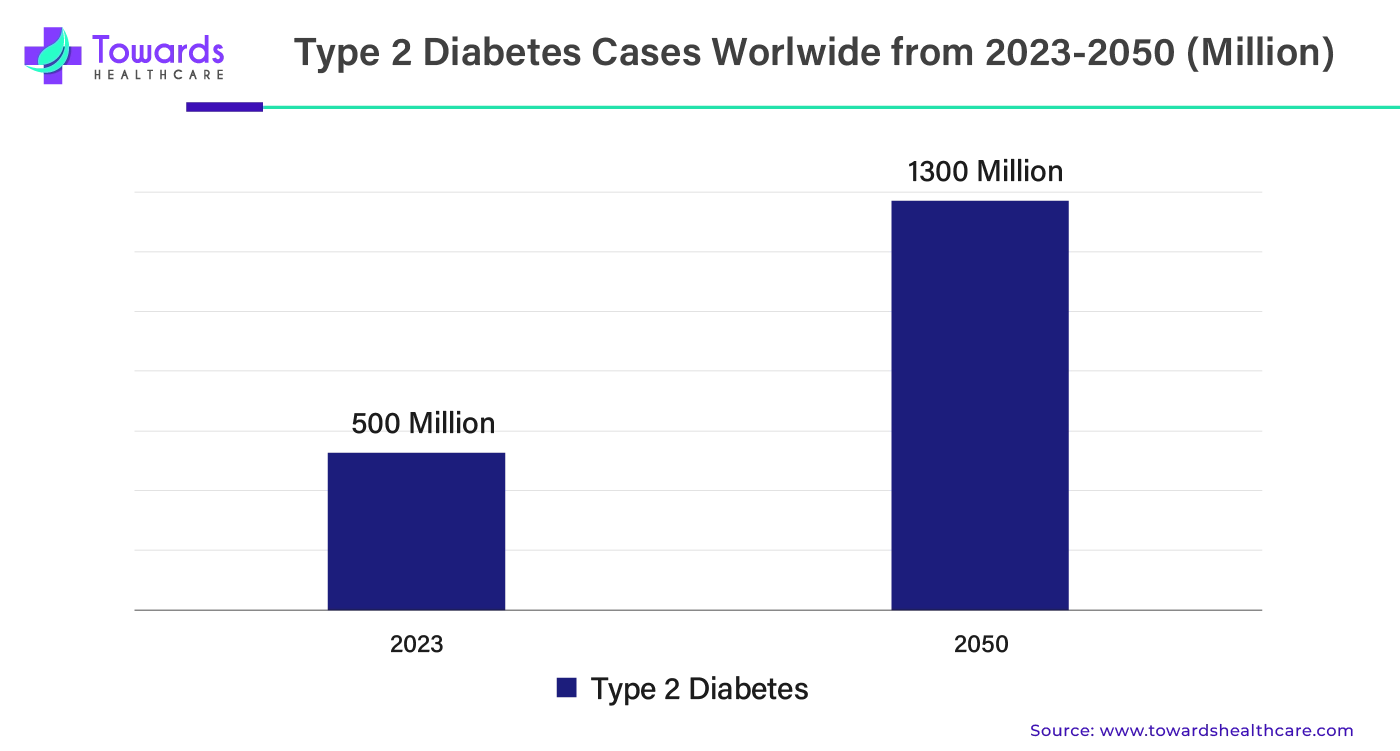
Diabetes is becoming more and more common, endangering human health and placing a heavy strain on healthcare systems worldwide. By regenerating insulin production and replacing damaged pancreatic beta cells, stem cell therapy has the potential to completely transform the management of diabetes. Researchers are investigating pluripotent stem cells as a potential tool for producing functioning beta cells in the lab and transplanting them into type 1 diabetic patients. This strategy might enhance blood sugar management and do away with the need for insulin injections, thereby improving the lives of individuals who are impacted by this illness.
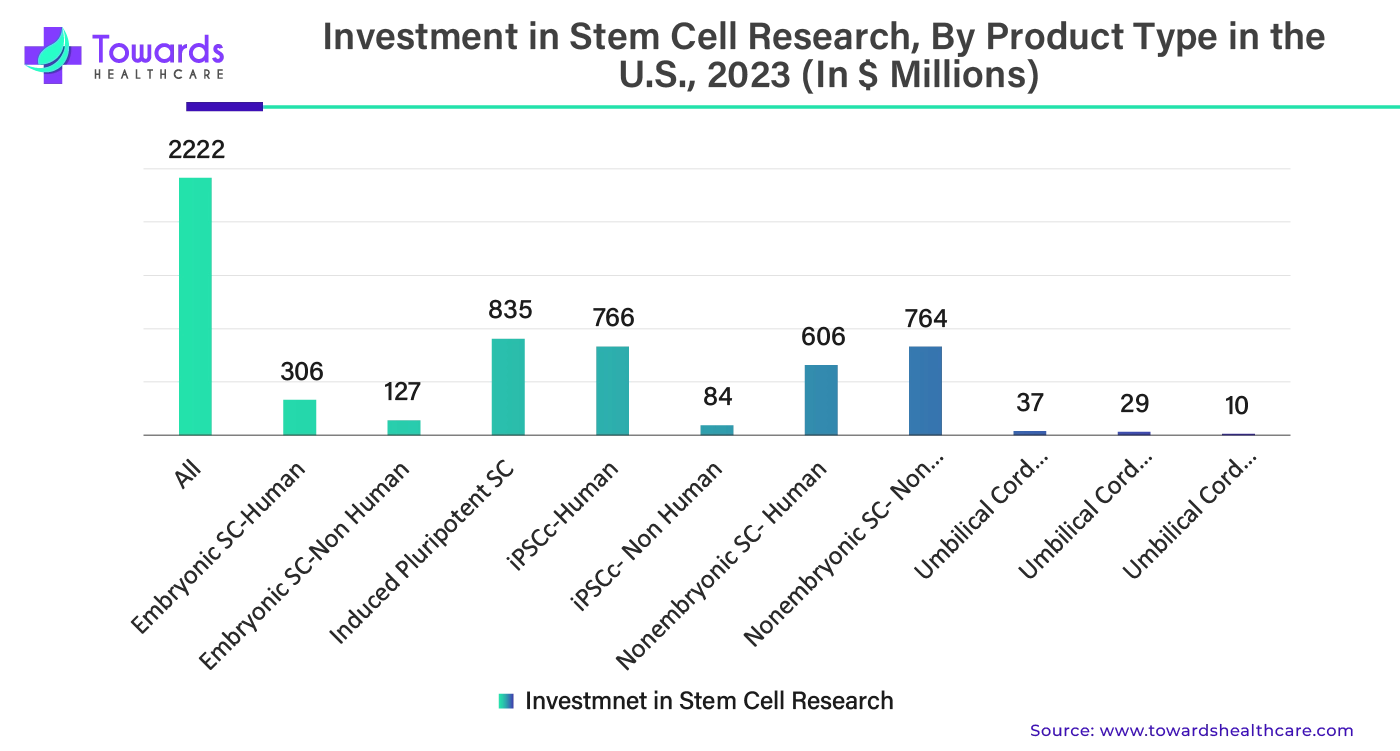
By product, the adult stem cells (ASCs) segment held the largest share of the stem cells market in 2023. All fully grown tissues contain adult stem cells, which contribute to the upkeep and development of these tissues over the course of their lives. Adult stem cells are the best and most secure stem cells to use for therapeutic purposes. Stem cell treatment is widely utilized in clinics to treat hematological malignancies. The use of adult stem cells has led to the development of novel techniques in recent years for repairing damaged cartilage.
For instance,
By product, the induced pluripotent stem cells (iPSCs) segment is expected to grow at the fastest rate in the stem cells market during the forecast period. Regenerative medicine has significant potential to develop with the use of induced pluripotent stem cell (iPSC) technology, which has revolutionized in vitro research. iPSCs are highly expandable, accessible to genetic modification, and capable of differentiating into the majority of somatic cell types. iPSCs have been widely used to create cell treatments, simulate human development and illnesses, and conduct drug screening.
For instance,
By application, the regenerative medicine segment dominated the stem cells market in 2023. The newest and most developing area of medicine is called "regenerative medicine," and it treats patients with chronic illnesses or catastrophic injuries by functionally restoring their tissues or organs. The groundwork for cell-based treatments for illnesses that traditional medications are unable to treat has been established by the astounding advancements in stem cell research.
| Regenerative Medical Products Approved in 2022-2023 in Japan | |
| Company Name | Product |
| Novartis Pharma K.K. | Kymriah Suspension for Intravenous Infusion |
| Janssen Pharmaceutical K.K. | Carvykti Suspension for Intravenous Infusion |
| Bristol-Myers Squibb K.K. | Breyanzi Suspension for Intravenous Infusion |
| Daiichi Sankyo Company, Limited | YESCARTA Intravenous Drip Infusion |
| Japan Tissue Engineering Co., Ltd. | JACEMIN |
| Aurion Biotech Japan, LLC. | Vyznova |
| Novartis Pharma K.K. | Luxturna Injection |
| Bristol-Myers Squibb K.K. | Abecma Intravenous Infusion |
By application, the drug discovery & development segment is anticipated to grow at the fastest rate in the stem cells market during the forecast period. The possibility of using stem cells to develop more effective medications to treat human disease is only one of the numerous reasons for interest in this field. The main idea is that stem cells can open up new avenues for research into the pathophysiological causes of disease, clinical trial patient selection, drug lead screening, and effectiveness and safety testing of potential drugs.
For instance,
By technology, the cell acquisition segment held the dominant share of the stem cells market in 2023. The most popular method for obtaining stem cells is to take out blood from the patient, extract the stem cells, and then put the blood back into the patient. Before, bone marrow was the primary source of blood stem cells, and this is where they formed. Stem cells are removed from the circulation directly these days. A peripheral blood stem cell transplant is the second technique, while a bone marrow transplant is the first.
By therapy, the allogenic segment dominated the stem cells market in 2023 and is estimated to show the fastest growth in the market during the forecast period. For "off-the-shelf" supply models, which are crucial in emergency medical circumstances, allogeneic techniques are especially well-suited. By using donor cells, these treatments enable the quick and easy preservation of medical supplies for the treatment of several patients. Time and resources are saved since this eliminates the need for customized cell preparation and retrieval. In addition to being more accessible and perhaps resulting in reduced manufacturing and patient expenses, allogeneic stem cell therapies can also scale more easily than autologous treatments.
For instance,
By end-use, the pharmaceutical & biotechnology companies segment held the largest stem cells market share and is anticipated to hold the dominant position during the forecast period. Companies in the biotechnology and pharmaceutical industries have recently shown a greater interest in stem cell biology. Since the majority of large pharmaceutical firms employ adult or embryonic stem cells for internal drug development programs, the usage of stem cells as research tools has increased. The knowledge gained from external collaborations with academic institutions or biotech firms frequently strengthens these internal initiatives. One of the main advantages that the pharmaceutical industry will contribute to the field of regenerative medicine is its extensive experience forming solid collaborations with clinical institutions and international regulatory authorities over many years.
For instance
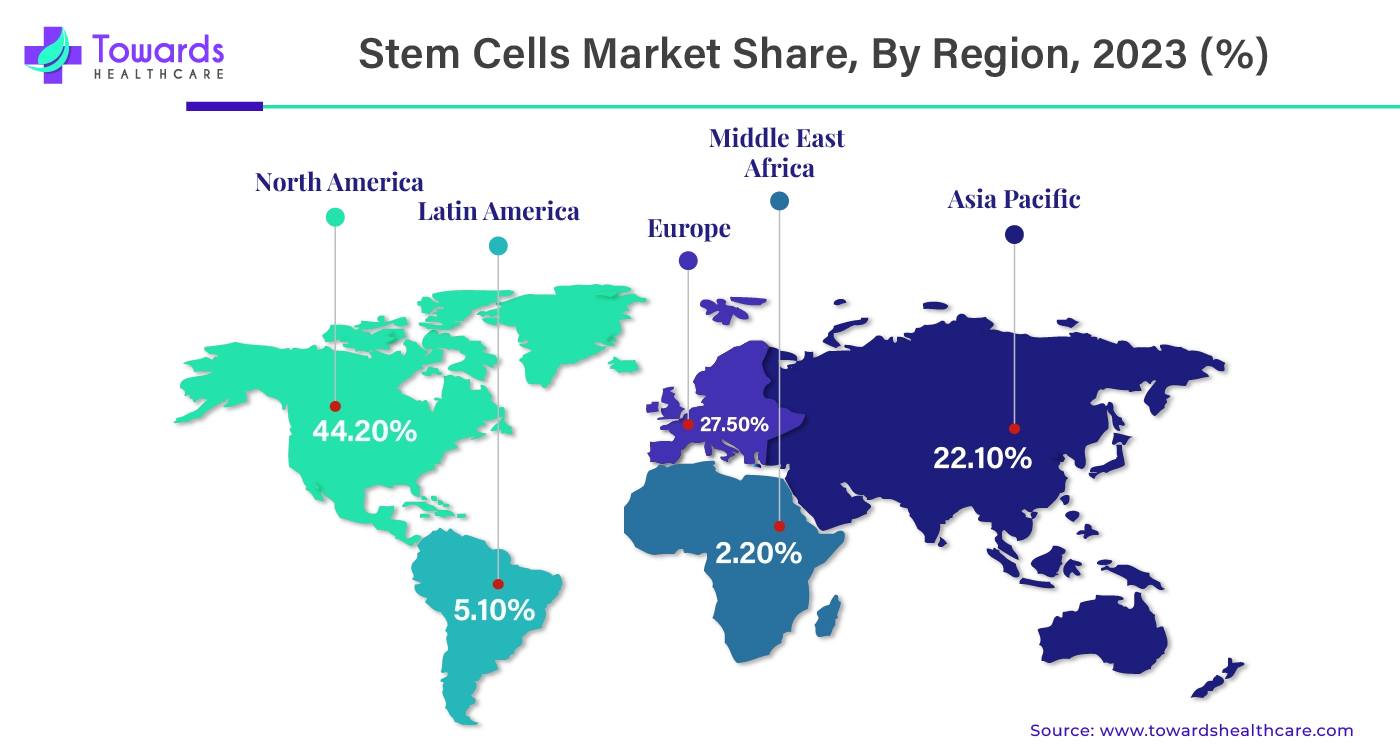
North America dominated the stem cells market share by 44.2% in 2023. Because there are so many significant market participants in North America, the region leads the global market. The market for stem cell therapies in this area is also being driven by government regulations, an advanced healthcare infrastructure, potential reimbursement, and growing awareness of stem cell therapies among the region's major populations. The regional market for stem cell therapy is attracting investors primarily because of the increased research and development efforts aimed at creating cutting-edge treatments and providing improved care to patients with life-threatening illnesses and medical professionals.
The U.S. holds the largest share of the stem cells market due to the presence of key market players and various research conducted by government bodies like NIH. With time, the NIH has invested in various stem cell research, which increases and promotes the usage of stem cells in various disease diagnoses and treatment development.
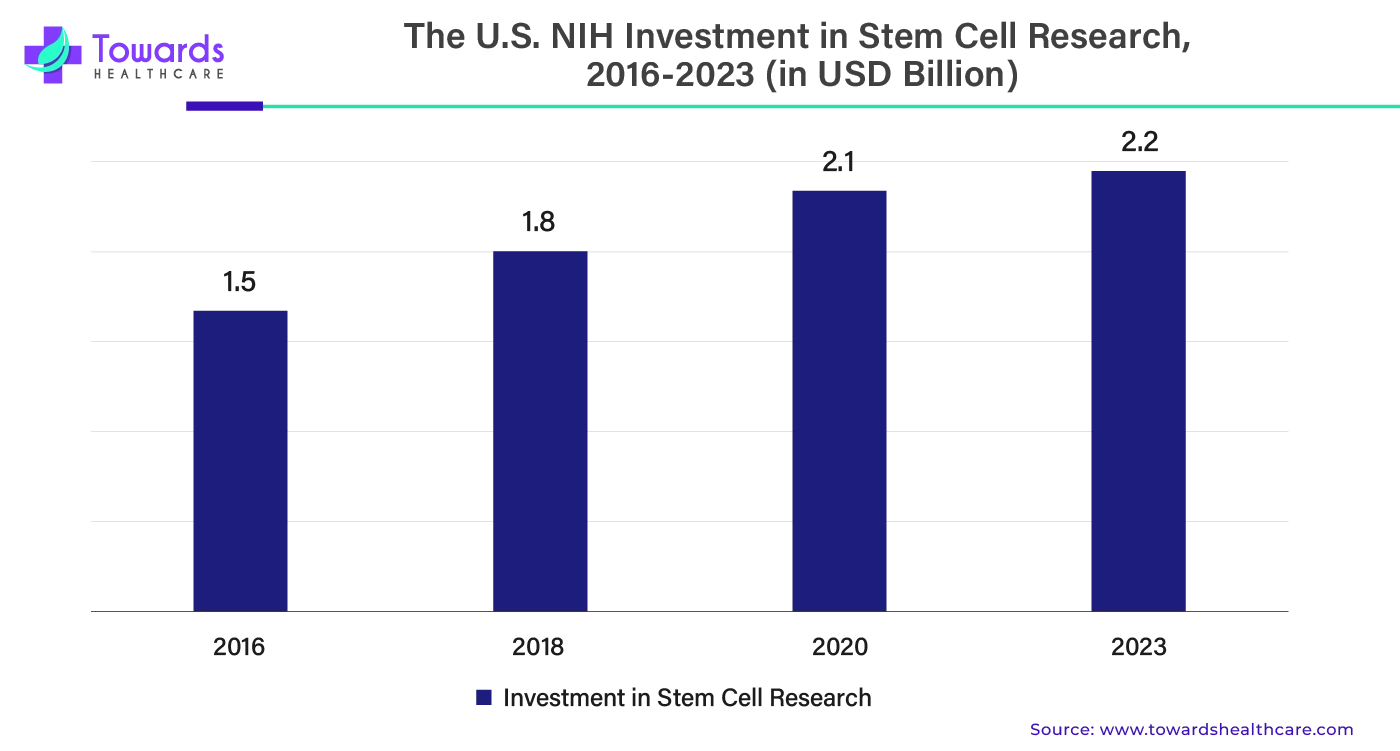
By region, Asia Pacific is expected to grow at the fastest rate during the forecast period. Because of its large patient population and strong product pipelines for stem cell-based therapies, the Asia Pacific area is expected to develop significantly. The market for stem cells is expected to grow significantly because of the rising prevalence of diseases, including diabetes, cancer, and neurological issues. In addition, government funding targeted at accelerating stem cell research supports the region's growth.
For instance,
| Company Name | Mayo Clinic |
| Headquarters | Minnesota, U.S., North America |
| Recent Development | In January 2024, NASA sent new stem cell research from the Mayo Clinic into orbit. The study aims to investigate the impact of gravity on mesenchymal stem cells, which are adult stem cells with growth factors and the ability to mend, which are produced from bone marrow. |
| Company Name | STEMCELL Technologies Inc. |
| Headquarters | Vancouver, Canada, North America |
| Recent Development | In January 2024, the largest biotechnology business in Canada, STEMCELL Technologies, announced the purchase of Propagenix Inc., a Maryland-based company that specializes in creating technologies that support novel regenerative medicine techniques. The purchase of Propagenix represents a significant advancement for Canada's biotechnology sector and a milestone in STEMCELL's growth trajectory. |
By Product
By Application
By Technology
By Therapy
By End-use
By Region
December 2025
December 2025
November 2025
October 2025